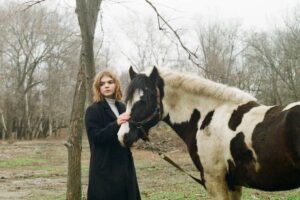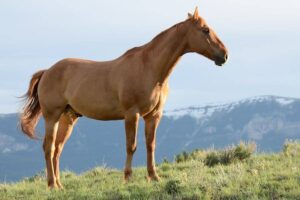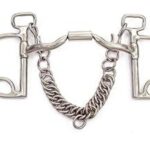Table of Contents
Choosing the right horse breed for a homestead is a critical decision that depends on various factors, including the horse’s temperament, physical characteristics, trainability, work performance, health, lifespan, and maintenance requirements.

Two breeds often considered for homestead use are the Paint Horse and the Quarter Horse.
This article will compare these two breeds across several criteria to help you make the best choice for your specific needs.
Paint Horse History
The American Paint Horse is a unique combination of the conformational characteristics of a western stock horse and the distinctive color patterns of pinto spotting.
The breed’s roots can be traced back to horses introduced by Spanish explorers, which were later bred with Quarter Horses and Thoroughbreds to create the versatile and colorful Paint Horse we know today.
The American Paint Horse Association was formed in 1965 to preserve the breed’s history and promote its growth.
Quarter Horse History
Known as America’s horse, the Quarter Horse has a rich history dating back to the 1600s.
This breed was developed from a mix of English horses, imported to Virginia from England, and native horses of Spanish origin.
The breed earned its name due to its exceptional speed in quarter-mile races. In 1940, the American Quarter Horse Association (AQHA) was established to preserve, record, and promote the breed.
Physical Characteristics
Paint Horse Physical Traits
Paint Horses are known for their distinctive coat patterns, which include tobiano, overo, and tovero.
They typically stand between 14.2 and 16 hands high and have a muscular build, similar to that of a stock-type Quarter Horse.
Paints come in virtually all colors, including bay, black, chestnut, and palomino, all combined with white patches.
Quarter Horse Physical Traits
Quarter Horses are well-muscled and compact, typically standing between 14 and 16 hands high. They are renowned for their powerful hindquarters, which contribute to their speed and agility.
The breed comes in a variety of solid colors, including sorrel, bay, black, brown, buckskin, palomino, gray, dun, red dun, grullo, and roan.
Temperament and Personality
Paint Horse Temperament
Paint Horses are known for their calm and friendly disposition, making them excellent choices for families and novice riders.
They are intelligent, versatile, and willing to please, traits that make them suitable for various equestrian disciplines and homestead tasks.
Quarter Horse Temperament
Quarter Horses are often praised for their docile and reliable temperament. They are generally calm, easy-going, and amiable, making them suitable for riders of all levels.
Their intelligence and eager-to-please nature make them highly trainable and versatile in different work situations.
Trainability and Learning Ability
Paint Horse Trainability
Paint Horses are intelligent and quick learners. They respond well to consistent, positive training methods.
Their versatility makes them suitable for a wide range of activities, from ranch work to recreational riding, and even competitive equestrian sports.
Quarter Horse Trainability

Quarter Horses are known for their exceptional trainability. They are intelligent, attentive, and have a natural willingness to work with humans.
These traits, combined with their physical abilities, make them highly adaptable to various types of work and equestrian sports.
Work and Performance
Paint Horse Work Performance
Paint Horses are hardworking and adaptable, capable of performing various tasks around a homestead.
They excel in cattle work, thanks to their agility and speed. Additionally, their calm temperament and versatility make them great for riding, driving, and even therapeutic riding programs.
Quarter Horse Work Performance
Quarter Horses are renowned for their work ethic. They excel in tasks requiring speed and agility, such as herding cattle, and are equally competent in pulling carts or buggies.
Their strength, stamina, and calm demeanor make them a popular choice for various homestead tasks.
Health and Lifespan
Paint Horse Health and Lifespan
Paint Horses are generally healthy and robust, with a life expectancy of 25 to 30 years.
Like all breeds, they can be prone to certain genetic disorders, including lethal white syndrome associated with the overo color pattern.
Regular veterinary care and appropriate management can help ensure a long, healthy life.
Quarter Horse Health and Lifespan
Quarter Horses are known for their robust health and typically have a lifespan of 25 to 35 years.
Some lines may be predisposed to certain genetic conditions, such as hereditary equine regional dermal asthenia (HERDA), but overall, they are a hardy and resilient breed.
Maintenance and Upkeep
Paint Horse Maintenance
The maintenance requirements for Paint Horses are similar to those of other horse breeds.
They require regular exercise, a balanced diet, routine hoof care, and regular veterinary check-ups. Their colorful coat may require extra grooming to keep it looking its best.
Quarter Horse Maintenance
Quarter Horses, being a hardy breed, have relatively low maintenance needs. They require a balanced diet, regular exercise, and routine health care. Their short, thick coats are easy to groom and maintain.
Adaptability to Climate
Paint Horse Climate Adaptability
Paint Horses are generally quite adaptable to various climates. Originating in North America, they have been bred in a range of environments.
They tend to be resilient and hardy, capable of withstanding both hot summers and cold winters.
However, their unique coat patterns may make them more susceptible to sunburn in extremely sunny climates.
Thus, in such conditions, they may require additional protection like shaded areas or sunblock for horses.
Quarter Horse Climate Adaptability
Quarter Horses are known for their adaptability and can thrive in a variety of climates.
Their dense coat provides warmth during colder months, while their ability to sweat efficiently helps regulate body temperature in the heat.
However, regardless of breed, individual horses may need time to acclimate to significant changes in climate, and appropriate shelter and care should always be provided to ensure their comfort and health.
Cost of Ownership

Paint Horse Ownership Cost
The cost of owning a Paint Horse can vary widely depending on factors such as age, training, pedigree, and location.
Beyond the initial purchase price, which can range from a few hundred to several thousand dollars, owners should budget for ongoing costs such as feed, veterinary care, farrier services, and potential boarding fees.
Additionally, due to their distinctive coat, Paint Horses may require additional grooming supplies or care.
Quarter Horse Ownership Cost
Quarter Horses, being one of the most popular breeds, have a wide price range depending on factors like age, bloodline, training, and conformation.
The ongoing costs of ownership are similar to those of other horse breeds, including feed, routine veterinary and farrier care, and boarding if applicable.
As a versatile breed, they may also incur costs related to specific activities they are involved in, such as rodeo events, racing, or show jumping.
Suitability for Children and Novice Riders
Paint Horse Suitability for Beginners
Paint Horses, with their generally calm and friendly disposition, are often recommended for children and novice riders.
Their versatility and willingness to please make them a good choice for those learning to ride or handle horses.
However, like any breed, individual temperaments can vary, and it’s crucial to find a horse whose energy level and personality match the rider’s skill and confidence levels.
Quarter Horse Suitability for Beginners
Quarter Horses are known for their docile and reliable temperament, traits that make them suitable for beginners.
They are often used in riding schools and therapeutic riding programs, which is a testament to their gentle nature and patience.
Their compact size and strength also make them a manageable and safe choice for children or inexperienced riders.
As always, a beginner should be paired with a well-trained, experienced horse regardless of breed.
Conclusion
Both Paint and Quarter Horses are excellent choices for a homestead, each offering unique strengths.
Paints stand out with their distinctive colors and patterns and are versatile, friendly, and trainable.
Quarter Horses impress with their strong work ethic, speed, and agility. The choice between the two ultimately depends on your specific needs, preferences, and the tasks you need your horse to perform.
Both breeds have a rich history, strong health, and long lifespans, making them worthy additions to any homestead.









![Screws or Nails for Framing - Which Should I Use? [Guide] Screws or Nails for Framing - Which Should I Use? [Guide]](https://homesteadandprepper.com/wp-content/uploads/2021/10/Nails-or-screws-for-framing-150x150.jpg)